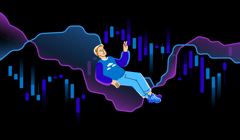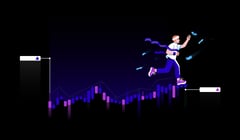
If you’ve trekked through the tall grasses of the trading world, you may have heard some expressions like “The market is bullish/bearish,” or “A bull run has started in the stock market.” You may have also seen the statue of a bull placed directly on Wall Street in New York City. Why do market players refer to animals such as bulls, bears, or others when talking about trading, and the stock market in particular? What do these animals represent?
Below, you’ll find a list of the animals most commonly referred to in trading and the meaning behind each of them.
Contents:
Interact with the underlined words and green dots to get additional details and explanations.
Additional context for the visuals.
Explanations and definitions of terms.
🐂 Bulls
One of the most prominent and commonly referenced animals in the stock market are bulls. Traders and investors who are positive toward the market are called bulls. Bulls are always optimistic and believe that the market will always move up. Even if an event causes the price of a stock to decline, bulls are always present to support and move the price higher. Prior to his recent passing, Rakesh Jhunjhunwala was considered “The Big Bull” of the Indian stock market. An uptrend in the stock market represents that the bulls are active and moving the price up with their horns.
🐻 Bears
Bears are the archenemy of bulls. Representing the exact opposite mindset of bulls, they are pessimistic investors and believe that the price will go down after a certain point. The rivalry between bulls and bears is what makes the market move up and down. Bears act as resistance to upward price action and try to move the price down. A downward trend in the stock market means that the bears are active and moving the price down with their heavy paws.
🐰 Rabbit
Rabbits are the traders that trade for a very short duration. These traders do not hold position for a long time, instead moving in and out of the market within minutes. Rabbits are mostly intraday traders and scalpers that are looking to make a quick buck in the span of just minutes or hours. These types of traders make multiple trades in a day to achieve their profit targets.
🐢 Tortoises
You’ve likely heard the story of the tortoise and the hare. Just like bulls and bears, they are the exact opposite of each other. Taking their time to buy and sell assets after a long period, tortoises do not care about short-term corrections and fluctuations, as they are interested in the long-term performance of stock. Tortoise traders sometimes incur a loss after buying a stock, but it doesn’t matter to them, as long-term performance is what concerns them.
🐌 Snails
Snails are investors that play safely in the stock market. Satisfied by the minimum returns they get after investing, snail investors invest in life insurance, policies and fixed deposits, and get annual returns. One major disadvantage of being a snail investor is that a large chunk of returns is eaten by inflation, which some snail investors are unaware of.
🐔 Chicken
Chickens are always fearful of the stock market. These investors panic if a market or asset experiences a sudden correction. Chickens don’t like to get their feathers ruffled — they don’t take many risks and try to play it safe. However, chickens are the ones who are crushed more than any other market player, as they can invest and trade randomly without any analysis, or on the basis of tips and calls. Most of the time, though, chickens stay out of the market and invest safely in bonds and deposits.
🐷 Pigs
The early beginner’s luck in the stock market makes some traders and investors greedy. These investors and traders want to make big money in a very short period of time. To satisfy their greed, pigs are ready to take on high levels of risk while ignoring the loss if the price moves against their expectations. These investors and traders try to get as much as they can from the market irrespective of its conditions. Because of this trait, they get slaughtered every time and are considered the market’s biggest losers.
🦅 Hawks
Hawks are investors that keep a steady eye on their target stock. They analyze their target closely, just like a hawk does before catching its prey. They make proper judgment before landing on any investment, and only after they are sure enough that the stock is going to perform, they catch it. Mainly policy makers and bankers are called hawks, who want to curb inflation by increasing interest rates. The opposite of hawks are doves, who want low interest rates.
🐺 Wolves
Wolves are traders that take advantage of loopholes in the market and make money unethically. Very powerful in terms of money, political relations or otherwise, wolves manipulate the market for their own financial gain. If you’ve seen the film The Wolf of Wall Street, in which Leonardo Di Caprio portrays the iconic role of Jordan Belfort, you’ll have a deeper understanding of how wolves work.
🐦 Ostriches
When hard times hit, ostriches bury their heads in the ground, hoping that the trouble will eventually pass. These investors often ignore negative impacts on their portfolio and sit idle doing nothing, believing that it’s just a matter of time before the market goes back to normal.
🦈 Sharks
Sharks are traders and investors who work collectively to manipulate the market. They can increase the price of a stock by trading amongst themselves, which lures in retail traders who are attracted by the increasing price. Once the retail traders start purchasing, sharks dump the stock as fast as they can and disappear. Sharks are a dangerous sign for retail investors, and spotting one in the market is very difficult.
🐋 Whales
Whale investors are usually institutions with big pockets, but can also be high-net-worth individuals. They drive the price of a stock by placing a massive order, the sheer size of which can swing the mood of the market in any direction. It’s possible for retail investors and traders to profit by investing alongside a whale. In any case, traders and investors should identify whales and keep an eye on them to know the future position of the market.
Conclusion
It’s a jungle out there, but a little common knowledge about the market can go a long way in your trading journey. Identifying each of these animals will give you a clearer view of the market’s conditions, and knowing which of them you are will give an indication of how you respond to the market’s movements, and where to improve to maximize your profits. Don’t forget that understanding the wild animal kingdom of the market will only get you so far without technical analysis and money management. Olymp Trade’s tools, insights, forecasting and help center are all there so you can succeed. For beginners, there’s a lot to learn before you’ll become the next big bull or whale — but don’t worry, we’ll be there every step of the way.
Risk warning: The contents of this article do not constitute investment advice, and you bear sole responsibility for your trading activity and/or trading results.
Traders who buy and hold an asset for a short period of time, from one to five minutes.
“Slow and steady wins the race.”











